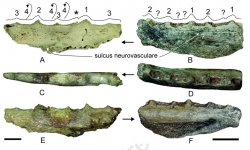albertonykus
Well-known member
Acosta Hospitaleche, C. and M. Reguero (2020)
Additional Pelagornithidae remains from Seymour Island, Antarctica
Journal of South American Earth Sciences (advance online publication)
doi: 10.1016/j.jsames.2020.102504
https://www.sciencedirect.com/science/article/pii/S0895981120300171
Two incomplete mandibles are assigned to Pelagornithidae given the presence of a well marked neurovascular furrow and the unique bony projections, or “pseudo-teeth”, along the crista tomialis. Specimens IAA-Pv 175 from Ypresian levels of La Meseta Alloformation (Cucullaea I Allomember), and IAA-Pv 823 from Bartonian beds of the Submeseta Alloformation, in Seymour Island (Antarctic Peninsula, West Antarctica) corresponds to the morpho-type 1, previously proposed for Antarctic pseudo-tooth birds.
The intermediate condition of the pseudo-teeth of these specimens reinforces the idea that diet changed from piscivory to molluscivory along the evolutive history of the group.
Additional Pelagornithidae remains from Seymour Island, Antarctica
Journal of South American Earth Sciences (advance online publication)
doi: 10.1016/j.jsames.2020.102504
https://www.sciencedirect.com/science/article/pii/S0895981120300171
Two incomplete mandibles are assigned to Pelagornithidae given the presence of a well marked neurovascular furrow and the unique bony projections, or “pseudo-teeth”, along the crista tomialis. Specimens IAA-Pv 175 from Ypresian levels of La Meseta Alloformation (Cucullaea I Allomember), and IAA-Pv 823 from Bartonian beds of the Submeseta Alloformation, in Seymour Island (Antarctic Peninsula, West Antarctica) corresponds to the morpho-type 1, previously proposed for Antarctic pseudo-tooth birds.
The intermediate condition of the pseudo-teeth of these specimens reinforces the idea that diet changed from piscivory to molluscivory along the evolutive history of the group.





